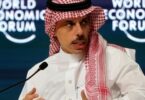Simon Henderson
Gulf watchers were surprised, even incredulous, when the image of three Gulf leaders was tweeted from the account of the private office of Saudi crown prince Muhammad bin Salman on September 17. Apparently taken earlier that day, the photo shows MbS, as he is known, standing between Emir Tamim bin Hamad al-Thani of Qatar and Sheikh Tahnoun bin Zayed al-Nahyan, the national security advisor of the United Arab Emirates, a son of the country’s founder, and a full brother of its effective leader, Crown Prince Muhammad bin Zayed, known as MbZ. All three were wearing beach clothes and smiling broadly.
The photo spread quickly on social media because it indicated that simmering antagonism between the UAE and Qatar was over. Confirmation that the photo was indeed genuine came shortly afterward, when it was tweeted by the Saudi Gazette, an English-language newspaper. It also dominated the September 18 front page of Arab News, a larger English-language Saudi newspaper, under the headline “A Relaxed Meeting at the Red Sea.” The meeting was additionally reported in the UAE, including by Gulf News, a Dubai paper.
The surprise was that from 2017 until early this year, a major rift had divided Qatar from Saudi Arabia, the UAE, Bahrain, and Egypt. These countries had accused Qatar of a range of unacceptable activities, including support for the Muslim Brotherhood and terrorism. Land borders were shut and air links stopped. But in January, the rift was declared over at a meeting of the countries’ leaders hosted by MbS at the Saudi desert resort of al-Ula. Details were unclear aside from the assertion of an end to accusations of interference in one another’s domestic affairs. Yet at the time, the UAE and Bahrain appeared to be reluctant to accept the reconciliation.
The last few weeks have seen several different diplomatic moves. On August 25, the Qatari foreign minister visited MbS in NEOM, his futuristic city being built on the Red Sea, and delivered what was described as a message from the Qatari leader. The next day, Sheikh Tahnoun, who is seen as a trusted and discreet envoy of MbZ, met in Qatar with Emir Tamim. In a possibly related trip, Sheikh Tahnoun had earlier that month visited Turkey’s President Recep Tayyip Erdogan, a supporter of Qatar whose forces maintain a military base near its capital. As tweeted, the latest development suggests another win for Qatar, following a boost in its international profile for having helped evacuate U.S and other foreign citizens as well as Afghans from Kabul amid the U.S. withdrawal.
The diplomacy should perhaps be seen in the context of Gulf leaders’ realization that U.S. official interest has fallen during the Biden administration relative to the Trump era. Recent high-level visits by American officials are reportedly a fraction of what they were under the former administration. The bid by MbS to use Saudi Arabia’s regional diplomatic clout to end the Gulf rift earlier this year was seen as a gesture toward the incoming White House, which was perceived as wanting to distance itself from the crown prince because of his links to the murder of dissident journalist Jamal Khashoggi. The degree to which this approach has worked is unclear: the Biden administration remains cautious toward MbS, although after initial hesitation it has voiced approval for the Abraham Accords, the name for the peace agreements signed between Israel and the UAE, as well as Bahrain and Sudan. On September 17, Secretary of State Antony Blinken led a virtual discussion with his counterparts in Israel, the UAE, Bahrain, and Morocco—which signed a deal with Israel parallel to but separate from the Abraham Accords—to mark the first anniversary of the normalization of ties.
The more exact significance of the MbS-Tamim-Tahnoun tweet will emerge with any reaction by the UAE’s MbZ, who was away on official visits to Paris and London last week, and also any response from Bahrain, which may feel sidelined. But for the moment, a photo and 140 characters have thrown upside down the presumptions of many on whether and how one of the thorny issues for U.S. diplomacy in the Gulf could be altered.
Simon Henderson is the Baker Fellow and director of the Bernstein Program on Gulf and Energy Policy at The Washington Institute.






